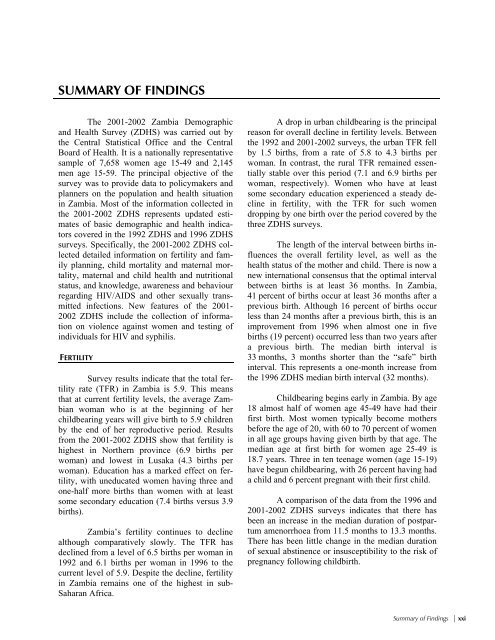Zambia Demographic and Health Survey 2001-2002 - Measure DHS
Zambia Demographic and Health Survey 2001-2002 - Measure DHS
Zambia Demographic and Health Survey 2001-2002 - Measure DHS
You also want an ePaper? Increase the reach of your titles
YUMPU automatically turns print PDFs into web optimized ePapers that Google loves.
SUMMARY OF FINDINGSThe <strong>2001</strong>-<strong>2002</strong> <strong>Zambia</strong> <strong>Demographic</strong><strong>and</strong> <strong>Health</strong> <strong>Survey</strong> (Z<strong>DHS</strong>) was carried out bythe Central Statistical Office <strong>and</strong> the CentralBoard of <strong>Health</strong>. It is a nationally representativesample of 7,658 women age 15-49 <strong>and</strong> 2,145men age 15-59. The principal objective of thesurvey was to provide data to policymakers <strong>and</strong>planners on the population <strong>and</strong> health situationin <strong>Zambia</strong>. Most of the information collected inthe <strong>2001</strong>-<strong>2002</strong> Z<strong>DHS</strong> represents updated estimatesof basic demographic <strong>and</strong> health indicatorscovered in the 1992 Z<strong>DHS</strong> <strong>and</strong> 1996 Z<strong>DHS</strong>surveys. Specifically, the <strong>2001</strong>-<strong>2002</strong> Z<strong>DHS</strong> collecteddetailed information on fertility <strong>and</strong> familyplanning, child mortality <strong>and</strong> maternal mortality,maternal <strong>and</strong> child health <strong>and</strong> nutritionalstatus, <strong>and</strong> knowledge, awareness <strong>and</strong> behaviourregarding HIV/AIDS <strong>and</strong> other sexually transmittedinfections. New features of the <strong>2001</strong>-<strong>2002</strong> Z<strong>DHS</strong> include the collection of informationon violence against women <strong>and</strong> testing ofindividuals for HIV <strong>and</strong> syphilis.FERTILITY<strong>Survey</strong> results indicate that the total fertilityrate (TFR) in <strong>Zambia</strong> is 5.9. This meansthat at current fertility levels, the average <strong>Zambia</strong>nwoman who is at the beginning of herchildbearing years will give birth to 5.9 childrenby the end of her reproductive period. Resultsfrom the <strong>2001</strong>-<strong>2002</strong> Z<strong>DHS</strong> show that fertility ishighest in Northern province (6.9 births perwoman) <strong>and</strong> lowest in Lusaka (4.3 births perwoman). Education has a marked effect on fertility,with uneducated women having three <strong>and</strong>one-half more births than women with at leastsome secondary education (7.4 births versus 3.9births).<strong>Zambia</strong>’s fertility continues to declinealthough comparatively slowly. The TFR hasdeclined from a level of 6.5 births per woman in1992 <strong>and</strong> 6.1 births per woman in 1996 to thecurrent level of 5.9. Despite the decline, fertilityin <strong>Zambia</strong> remains one of the highest in sub-Saharan Africa.A drop in urban childbearing is the principalreason for overall decline in fertility levels. Betweenthe 1992 <strong>and</strong> <strong>2001</strong>-<strong>2002</strong> surveys, the urban TFR fellby 1.5 births, from a rate of 5.8 to 4.3 births perwoman. In contrast, the rural TFR remained essentiallystable over this period (7.1 <strong>and</strong> 6.9 births perwoman, respectively). Women who have at leastsome secondary education experienced a steady declinein fertility, with the TFR for such womendropping by one birth over the period covered by thethree Z<strong>DHS</strong> surveys.The length of the interval between births influencesthe overall fertility level, as well as thehealth status of the mother <strong>and</strong> child. There is now anew international consensus that the optimal intervalbetween births is at least 36 months. In <strong>Zambia</strong>,41 percent of births occur at least 36 months after aprevious birth. Although 16 percent of births occurless than 24 months after a previous birth, this is animprovement from 1996 when almost one in fivebirths (19 percent) occurred less than two years aftera previous birth. The median birth interval is33 months, 3 months shorter than the “safe” birthinterval. This represents a one-month increase fromthe 1996 Z<strong>DHS</strong> median birth interval (32 months).Childbearing begins early in <strong>Zambia</strong>. By age18 almost half of women age 45-49 have had theirfirst birth. Most women typically become mothersbefore the age of 20, with 60 to 70 percent of womenin all age groups having given birth by that age. Themedian age at first birth for women age 25-49 is18.7 years. Three in ten teenage women (age 15-19)have begun childbearing, with 26 percent having hada child <strong>and</strong> 6 percent pregnant with their first child.A comparison of the data from the 1996 <strong>and</strong><strong>2001</strong>-<strong>2002</strong> Z<strong>DHS</strong> surveys indicates that there hasbeen an increase in the median duration of postpartumamenorrhoea from 11.5 months to 13.3 months.There has been little change in the median durationof sexual abstinence or insusceptibility to the risk ofpregnancy following childbirth.Summary of Findings | xxi








![Obtaining Informed Consent for HIV Testing [QRS4] - Measure DHS](https://img.yumpu.com/49850117/1/190x245/obtaining-informed-consent-for-hiv-testing-qrs4-measure-dhs.jpg?quality=85)







